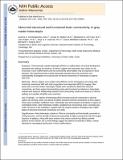Abnormal structural and functional brain connectivity in gray matter heterotopia
Author(s)
Christodoulou, Joanna; Walker, Linsey M.; Del Tufo, Stephanie N.; Katzir, Tami; Gabrieli, John D. E.; Gabrieli, Susan; Chang, Bernard S.; ... Show more Show less
DownloadGabrieli_Abnormal structural.pdf (2.685Mb)
OPEN_ACCESS_POLICY
Open Access Policy
Creative Commons Attribution-Noncommercial-Share Alike
Terms of use
Metadata
Show full item recordAbstract
Purpose: Periventricular nodular heterotopia (PNH) is a malformation of cortical development associated with epilepsy and dyslexia. Evidence suggests that heterotopic gray matter can be functional in brain malformations and that connectivity abnormalities may be important in these disorders. We hypothesized that nodular heterotopia develop abnormal connections and systematically investigated the structural and functional connectivity of heterotopia in patients with PNH.
Methods: Eleven patients were studied using diffusion tensor tractography and resting-state functional connectivity MRI with bold oxygenation level–dependent (BOLD) imaging. Fiber tracks with a terminus within heterotopic nodules were visualized to determine structural connectivity, and brain regions demonstrating resting-state functional correlations to heterotopic nodules were analyzed. Relationships between these connectivity results and measures of clinical epilepsy and cognitive disability were examined.
Key Findings: A majority of heterotopia (69%) showed structural connectivity to discrete regions of overlying cortex, and almost all (96%) showed functional connectivity to these regions (mean peak correlation coefficient 0.61). Heterotopia also demonstrated connectivity to regions of contralateral cortex, other heterotopic nodules, ipsilateral but nonoverlying cortex, and deep gray matter structures or the cerebellum. Patients with the longest durations of epilepsy had a higher degree of abnormal functional connectivity (p = 0.036).
Significance: Most heterotopic nodules in PNH are structurally and functionally connected to overlying cortex, and the strength of abnormal connectivity is higher among patients with the longest duration of epilepsy. Along with prior evidence that cortico-cortical tract defects underlie dyslexia in this disorder, the current findings suggest that altered connectivity is likely a critical substrate for neurologic dysfunction in brain malformations.
Description
available in PMC 2013 June 01
Date issued
2012-06Department
Massachusetts Institute of Technology. Department of Brain and Cognitive Sciences; McGovern Institute for Brain Research at MITJournal
Epilepsia
Publisher
John Wiley & Sons, Inc
Citation
Christodoulou, Joanna A., Linsey M. Walker, Stephanie N. Del Tufo, Tami Katzir, John D. E. Gabrieli, Susan Whitfield-Gabrieli, and Bernard S. Chang. “Abnormal Structural and Functional Brain Connectivity in Gray Matter Heterotopia.” Epilepsia 53, no. 6 (June 2012): 1024–1032.
Version: Author's final manuscript
ISSN
00139580